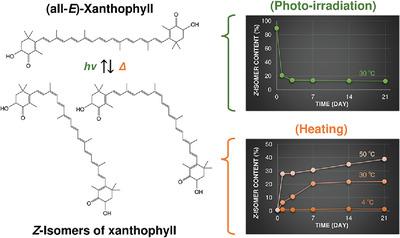当前位置:
X-MOL 学术
›
Eur. J. Lipid Sci. Technol.
›
论文详情
Our official English website, www.x-mol.net, welcomes your
feedback! (Note: you will need to create a separate account there.)
Thermal‐ and Photo‐Induced Isomerization of All‐E‐ and Z‐Isomer‐Rich Xanthophylls: Astaxanthin and Its Structurally‐Related Xanthophylls, Adonirubin, and Adonixanthin
European Journal of Lipid Science and Technology ( IF 1.8 ) Pub Date : 2020-04-06 , DOI: 10.1002/ejlt.201900462 Masaki Honda 1 , Toshiyasu Sowa 2 , Yuki Kawashima 2
European Journal of Lipid Science and Technology ( IF 1.8 ) Pub Date : 2020-04-06 , DOI: 10.1002/ejlt.201900462 Masaki Honda 1 , Toshiyasu Sowa 2 , Yuki Kawashima 2
Affiliation

|
The effects of heating and photo‐irradiation on the stability of all‐E‐isomer‐rich and Z‐isomer‐rich xanthophylls, astaxanthin and its structurally related xanthophylls, adonirubin, and adonixanthin, are investigated. The xanthophylls with high Z‐isomer content are prepared from their high‐purity all‐E‐isomers by thermal isomerization and filtering techniques, that is, total Z‐isomer ratios of adonirubin, astaxanthin, and adonixanthin are 80.9%, 89.5%, and 72.5%, respectively. The all‐E‐ and Z‐isomer‐rich xanthophylls dissolved in ethanol are stored at 4, 30, and 50 °C in the dark and at 30 °C under photo‐irradiation using a fluorescent light for 21 days. In the all‐E‐isomer‐rich xanthophylls, as the storage temperature increases, the total Z‐isomer ratio becomes higher, whereas in the Z‐isomer‐rich xanthophylls, the all‐E‐isomer ratio becomes higher. Photo‐irradiation slightly promotes Z‐isomerization in (all‐E)‐xanthophylls, but highly promotes all‐E‐isomerization in Z‐isomer‐rich xanthophylls. In addition, photo‐irradiation prevents thermal Z‐isomerization of (all‐E)‐xanthophylls. Moreover, it is found that some xanthophyll Z‐isomers such as (9Z)‐astaxanthin are more stable than that of the other Z‐isomers against heating and photo‐irradiation. These findings can contribute not only to establishing suitable storage conditions for Z‐isomer‐rich xanthophylls, but also to developing control techniques for the E/Z‐isomer ratio of the xanthophylls.
中文翻译:

全E和Z异构体丰富的叶黄素的热诱导和光诱导异构化:虾青素及其与结构相关的叶黄素,阿杜红素和Adonixanthin
研究了加热和光辐照对富含全E-异构体和富含Z-异构体的叶黄素,虾青素及其结构相关叶黄素,阿诺红素和Adonixanthin稳定性的影响。具有高Z异构体含量的叶黄素是通过热异构化和过滤技术由其高纯度的全E异构体制备而成的,也就是说,阿杜林,虾青素和Adonixanthin的Z异构体的总比例为80.9%,89.5%和分别为72.5%。全部-E和Z溶解在乙醇中的富含异构体的叶黄素在黑暗中于4、30和50°C下储存,在30°C的荧光灯下采用荧光灯储存21天。在富含全E异构体的叶黄素中,随着储存温度的升高,总Z异构体的比率变高,而在富含Z异构体的叶黄素中,所有E异构体的比率变高。光照射略微促进ž -isomerization在(清一色ē)-xanthophylls,但高度提升清一色ê -isomerization在ž丰富的异构体叶黄素。此外,光辐射可防止(all- E)的热Z异构化。叶黄素。此外,还发现一些叶黄素Z异构体,例如(9 Z)-虾青素,在加热和光辐照下比其他Z异构体更稳定。这些发现不仅可以为建立富含Z-异构体的叶黄素建立合适的储存条件,而且可以为开发控制叶黄素E / Z-异构体比率的控制技术做出贡献。
更新日期:2020-04-06
中文翻译:

全E和Z异构体丰富的叶黄素的热诱导和光诱导异构化:虾青素及其与结构相关的叶黄素,阿杜红素和Adonixanthin
研究了加热和光辐照对富含全E-异构体和富含Z-异构体的叶黄素,虾青素及其结构相关叶黄素,阿诺红素和Adonixanthin稳定性的影响。具有高Z异构体含量的叶黄素是通过热异构化和过滤技术由其高纯度的全E异构体制备而成的,也就是说,阿杜林,虾青素和Adonixanthin的Z异构体的总比例为80.9%,89.5%和分别为72.5%。全部-E和Z溶解在乙醇中的富含异构体的叶黄素在黑暗中于4、30和50°C下储存,在30°C的荧光灯下采用荧光灯储存21天。在富含全E异构体的叶黄素中,随着储存温度的升高,总Z异构体的比率变高,而在富含Z异构体的叶黄素中,所有E异构体的比率变高。光照射略微促进ž -isomerization在(清一色ē)-xanthophylls,但高度提升清一色ê -isomerization在ž丰富的异构体叶黄素。此外,光辐射可防止(all- E)的热Z异构化。叶黄素。此外,还发现一些叶黄素Z异构体,例如(9 Z)-虾青素,在加热和光辐照下比其他Z异构体更稳定。这些发现不仅可以为建立富含Z-异构体的叶黄素建立合适的储存条件,而且可以为开发控制叶黄素E / Z-异构体比率的控制技术做出贡献。











































 京公网安备 11010802027423号
京公网安备 11010802027423号